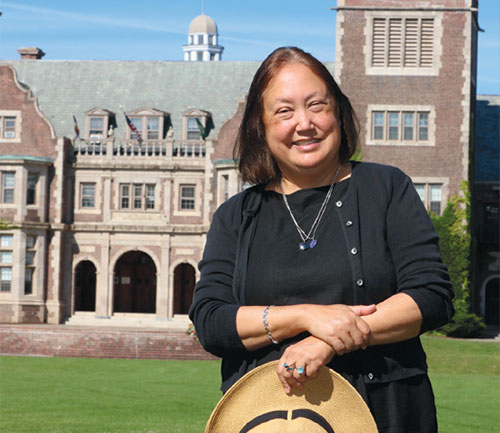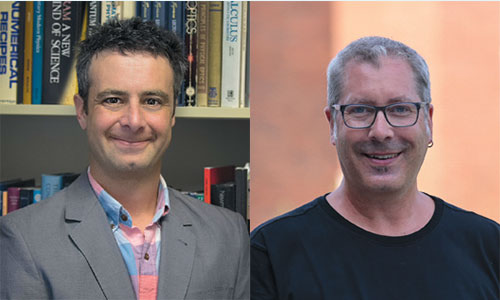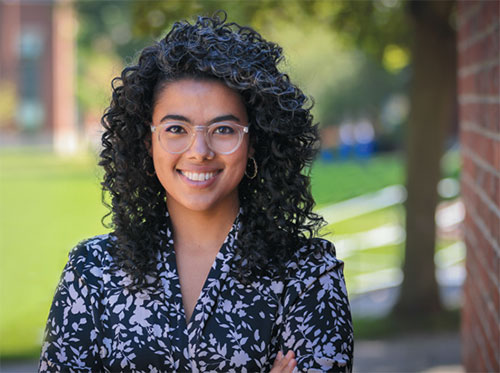Faculty News
2021 CAROLYN SHAW BELL AWARD

President Joyce P. Jacobsen
President Joyce P. Jacobsen is the recipient of the American Economic Association’s 2021 Carolyn Shaw Bell Award. Named for the first chair of the AEA’s Committee on the Status of Women in the Economics Profession, the award is given annually “to an individual who has furthered the status of women in the economics profession through example, achievements, increasing our understanding of how women can advance in the economics profession or mentoring others.” Jacobsen “excelled on all of these criteria,” as the AEA announcement noted. An “important scholar of labor economics and the economics of gender” and the first woman to serve as HWS president, Jacobsen “is an award-winning teacher, generous citizen of the profession, an exceptional advisor and mentor and a respected and skillful academic leader.” The award will be presented virtually during the 2022 AEA meeting.
MAKING HISTORY

Associate Professor of American Studies Kirin Makker
Associate Professor of American Studies Kirin Makker was featured in Good Morning America’s celebration of Asian Americans and Pacific Islanders who are “making history right now.” An architect, artist and writer, Makker was nominated by author Sejal Shah, who noted that the HWS professor “models collaborative work in her teaching, transcending conventional scripts. As a biracial/ bi-ethnic Asian American artist, her work begins from a point of multiple lenses. Makker is always searching for new ways of seeing, representing and moving through the world.” Pictured in the Saarinen-Knoll Womb Chair, Makker reimagined the icon of mid-century modern design for her project, The Womb Chair Speaks, with Abbey Frederick ’20 and Ainsley Rhodes ’19. Makker’s article about the project appears in the latest issue of Feminist Studies; another, co-authored with Frederick and Rhodes, is forthcoming in Art Journal. This fall, the Memorial Art Gallery in Rochester, N.Y., featured Makker’s “Blueprint Series,” which uses cyanotype on textiles and eggshells to “evoke the everyday, the below, the other, the queer, the unbelonging.” See what she’s working on, what her students are making and the occasional photo of her cat on Instagram @kirinmakker.
YOUR INTERNET BRAIN

Associate Professor of Psychological Science Daniel Graham and Associate Professor of Political Science Paul Passavant
Is the human brain a computer? This was the chief question posed in the Phi Beta Kappa lecture in 1971, when HWS celebrated Zeta Chapter’s centennial. Fifty years later, Associate Professor of Psychological Science Daniel Graham has an answer: the best metaphor for the brain is not a computer — it’s the internet. As Graham writes in his new book An Internet in Your Head, neuroscientists are realizing that beyond performing computations, “the brain also must communicate within itself…[and] communication systems rely on different fundamental design principles than those of computing systems.” This new paradigm, he argues, can open new avenues of research for neuroscientists to unravel the brain’s routing mechanisms and unlock its deepest secrets. Learn more on his Psychology Today blog, Your Internet Brain.
POLICING. PROTEST. POST-DEMOCRACY?
“Has the policing of protest become more aggressive and violent? If so, how did this happen? What does this mean?” asks Associate Professor of Political Science Paul Passavant in his new book, Policing Protest: The Post- Democratic State and the Figure of Black Insurrection. Published this summer by Duke University Press, the book analyzes political protests in the U.S. and how policing such events has become increasingly hostile toward demonstrators.
COLONIALISM IN THE DIGITAL AGE

Assistant Professor of Africana Studies Christine Goding-Doty
In a Los Angeles Review of Books interview this summer, Assistant Professor of Africana Studies Christine Goding-Doty described the connections between colonialism and “the pipes, cables [and] data centers” that power our devices and the internet. As part of the LARB series, “Antiracism in the Contemporary University,” Goding-Doty, who studies race in the digital age, discussed her research with Tung-Hui Hu, a poet, digital culture scholar and University of Michigan professor. She told Hu that where race is concerned, “we can focus on the actions and intentions and relations of human beings, but they belong to a larger context of non-human activity.”
FINDINGS
INTRIGUING FACULTY RESEARCH, REPORTED IN BRIEF*
Two planets were confirmed orbiting the Venus zone of a nearby dwarf star. ¶ Cuba’s economic isolation during the past 60 years helped limit the arrival and establishment of invasive plants. ¶ The cultural resurgence of the Lower Elwha Klallam Tribe, and conversations over the tribe’s future, are hampered by the lingering effects of the damming of the Elwha River in the early 20th century. ¶ A mathematical model explains why exposure to a low dose of hepatitis B leads to a slow expansion of the cells that fight the virus, and thus infection persists, but exposure to higher doses can lead to virus clearance. ¶ In the age of social media, multi-level marketing schemes exploit existing gender divides with faux-feminist rhetoric about female empowerment. ¶ Within 50 years of abandonment, post-agricultural forests contain a similar amount of biomass as older forests. ¶ Imaging microscopes and precision micromanipulators can be constructed DIY at a fraction of the cost of their commercially produced counterparts. ¶ Rainer Maria Rilke’s poems exert “an anxiety of influence” and “an anxiety of exile” on the work of Russian poet Marina Tsvetaeva. ¶ Most students in blended courses in Russian language found the combined video/in-person model preferable to the traditional course format. ¶ William Still, the first to document the Underground Railroad, saw his book as a cultural and political project as well as a road to financial autonomy for his employees, who, like Still himself, were once enslaved.
*visit hws.edu/findings for details

